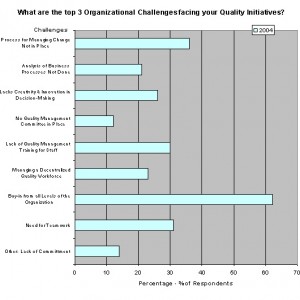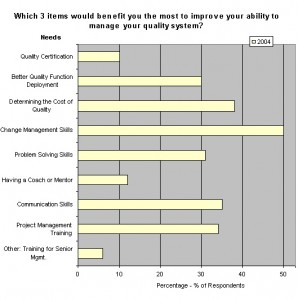
How to Manage the Top 3 Challenges Facing Your Quality Initiatives
Research undertaken at the 2004 American Society for Quality’s Annual Quality Congress held in Toronto, Canada revealed that sixty-two percent (62%) of the 343 respondents who completed a survey on quality initiatives found ‘Buy-in From All Levels of the Organization’ to be their major challenge. Additionally, respondents mentioned ‘Process for Managing Change Not In Place’ (36%) and ‘Poor Project Management Skills’ (33%) as their next most difficult challenges.
This research provides a snapshot of the issues facing organizations in the management of their quality initiatives. It also asked quality practitioners what they felt would benefit them most to improve their ability to manage their quality systems and here is what they said:
- Change Management Skills (50%)
- Determining the Cost of Quality (38%)
- Project Management Training (34%)
Other challenges identified in the research that are facing organizations when implementing quality initiatives were:
- Lack Creativity and Innovation in Decision-Making
- Managing a Decentralized Quality Workforce
- Analysis or Reengineering of Business Processes Not Done
- No Quality Management Committee in Place
Business Improvement Architectt’s research uncovered ‘Change Management Skills’, as the number one item, that quality practitioners felt would benefit them the most in improving their ability to manage quality initiatives. In addition, the following items were identified in descending order:
- Determining the Cost of Quality
- Communication Skills
- Project Management Training
- Quality Management Training
- Problem Solving Skills
- Quality Functional Deployment
- Having a Coach or Mentor
- Quality Certification
- Training for Senior Management
Most quality initiatives involve change for the organization and all change requires buy-in. The research provides evidence that Quality Practitioners would benefit from a greater understanding of change management.
Here are some strategies for Quality Practitioners to help them better manage changes that come up during the implementation of their quality initiatives:
#1—Learn the Process for Managing Change
There are numerous quality initiatives that organizations are undertaking today such as: Six Sigma, Lean Manufacturing, Quality Awards, Process Management, Reengineering, ISO Implementation/Re-certification and Quality Service. Senior management must consider the organization’s culture; the work environment and the actual work performed by their staff, as the quality initiatives are implemented so purported benefits are delivered.
Other changes that impact an organization as quality initiatives are implemented include supporting the strategic plan for the organization internally and externally meeting changing customer needs.
As a result, the quality practitioner needs to understand the change management process and how it helps with the successful implementation of a quality management initiative.
Here are some steps to help you manage change and get buy-in from all levels of the organization:
1. Identify the key objectives of the quality initiative.
- Make sure you understand the business case for the quality initiative at the start. If the quality initiative’s objectives are not clearly linked to departmental and organizational strategy, it increases the likelihood of failure.
2. Create a Steering Committee to oversee the entire process of change.
- This cross-functional team will oversee the entire process of change. They will suggest alternative corrective or preventative actions in the event that the quality initiative is moving away from its original target.
3. Communicate to everybody in the organization that is affected by the change.
- Continuous communication to everybody in the organization that is affected by the change helps enormously in implementing the quality initiative. To start off the communication process, form small focus groups of cross-functional and cross levels of employees. Use these focus groups to identify what type and frequency of communication is required such as: town-hall meetings, newsletters, periodic status reports, e-mails, etc. Ask these focus groups to identify concerns, challenges and opportunities about the quality initiative implementation process.
4. Undertake a Culture Review
- Organizational culture is the commonly held attitudes, values, beliefs and behaviours of its members. The culture of an organization is as unique and diverse as an individual’s personality.
- If the members of an organization believe that change is something to be feared and avoided, then change implementation is often reactive and haphazard. If the members believe that all change should be aggressively implemented “from above”, then change is seldom supported. However, if the members of an organization believe that change is exciting and everyone’s responsibility, then change and growth occur with relative ease. These are the few “excellent” organizations that continue to excel in their industry.
-
An organizational culture inventory can be used for an organization to assess:
- Their current organizational culture.
- Obtain information and insight regarding the type of culture that supports quality and effectiveness.
- Gauge their readiness for change…to traverse the journey.
- Identify and address organizational forces likely to drive or impede cultural change.
- Create a vision for the organization’s cultural “ideal”.
- Define the specific changes that need to take place.
- You may choose to work with your Human Resources department or bring in a consultant such as Business Improvement Architects (BIA) to conduct the Culture Review.
5. Implement training
- There is always a training component where change is involved. Training for staff can include: “How To Cope with the Stress of a Change You Didn’t Want” and training for managers can include “How to Create a Quality Environment” and “Management’s Role in Ensuring Success in the Execution of Quality Initiatives”. These programs can help prepare staff for changes to come.
#2—Acquire Project Management Skills
Quality Initiatives are really projects. However, they are often managed as a series of unrelated tasks performed by many different people and not at all connected. At times, an outside consulting firm is used to help drive the initiative. Usually, their approach and their plan, is not shared with the organization. So the organization has tasks to perform and the consultant has tasks to perform but these are not necessarily linked. This creates cost overruns, time overruns and customer dissatisfaction.
A definition of a project is “A temporary endeavour undertaken to create a unique product, service or other measurable end-result.” We often equate this to something that only the IT department does. However, this couldn’t be further from the truth. Everyone engaged in a quality initiative is essentially managing a project and the same process or methodology must be used to manage a quality initiative as to the management of all other projects within the organization.
This presents an opportunity for quality practitioners. Through training, they will gain the skills necessary to manage their quality initiatives more effectively. They will also be able to understand the need to link their project plans with those of their consultants and learn how to ensure that their projects are managed with the constraints of time, cost and other resources. Successful management of their projects will help them to gain the buy-in from all levels within their organizations.
#3—Implement Quality Management Training Programs for Staff
In the late 1980s through to the early 1990s Quality Practitioners received rigorous training because ‘Total Quality Management’ (TQM) became a popular strategy for organizational change and training was an important element within this initiative.
However, new “flavours” became the norm and the old TQM took on new names, new directions and so on. In so doing, some of the TQM basic principles were lost including: the customer focus, the understanding of the change, cultural issues and finally, the training. Team Training and Cost of Quality Training were common components of the TQM initiative and these seem to have been lost over time. It is now apparent that organizations need to go back to some of the basics and ensure that their quality practitioners are properly trained in the various quality tools that will ensure they are able to meet all of their competency requirements.
Conclusion
Getting buy-in from all levels of your organization will require an understanding of the process for managing change and an understanding of project management. Change initiatives are projects and, as such, follow a project management process with the following project steps:
- Project initiation
- Project definition
- Project planning
- Project execution
- Project closing.
Furthermore, quality practitioners should request training in Quality Management techniques to improve their teamwork.



